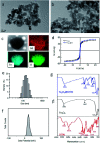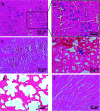An ultra-sensitive T 2-weighted MR contrast agent based on Gd3+ ion chelated Fe3O4 nanoparticles
- PMID: 35517217
- PMCID: PMC9053615
- DOI: 10.1039/d0ra01807d
An ultra-sensitive T 2-weighted MR contrast agent based on Gd3+ ion chelated Fe3O4 nanoparticles
Abstract
An ultra-sensitive T 2-weighted MR imaging contrast agent was prepared based on Fe3O4 nanoparticles and Gd3+ ions (Fe3O4@Gd). Amino modified Fe3O4 nanoparticles were conjugated to diethylenetriamine pentaacetic acid, and finally coordinated with Gd3+ ions. The nanoparticles had a uniform morphology with a size of 100 nm and a Gd/Fe mass ratio of 1/110. The r 2 (transverse relaxivity) of the Fe3O4 nanoparticles increased from 131.89 mM-1 s-1 to 202.06 mM-1 s-1 after coordination with Gd3+ ions. MR measurements showed that the aqueous dispersion of Fe3O4@Gd nanoparticles had an obvious concentration-dependent negative contrast enhancement. Hepatoma cells were selected to test the cytotoxicity and MR imaging effect. The application of Fe3O4@Gd nanoparticles as contrast agents was also exploited in vivo for T 2-weighted MR imaging of rat livers. All the results showed the effectiveness of the nanoparticles in MR diagnosis.
This journal is © The Royal Society of Chemistry.
Conflict of interest statement
The authors declare no conflict of interest.
Figures








Similar articles
-
Gd(iii) complex conjugated ultra-small iron oxide as an enhanced T1-weighted MR imaging contrast agent.J Mater Chem B. 2015 Feb 21;3(7):1433-1438. doi: 10.1039/c4tb01981d. Epub 2015 Jan 13. J Mater Chem B. 2015. PMID: 32264494
-
Gadolinium-labelled iron/iron oxide core/shell nanoparticles as T 1-T 2 contrast agent for magnetic resonance imaging.RSC Adv. 2018 Jul 26;8(47):26764-26770. doi: 10.1039/c8ra04530e. eCollection 2018 Jul 24. RSC Adv. 2018. PMID: 35541075 Free PMC article.
-
Targeted MR Imaging Adopting T1-Weighted Ultra-Small Iron Oxide Nanoparticles for Early Hepatocellular Carcinoma: An in vitro and in vivo Study.Chin Med Sci J. 2020 Jun 30;35(2):142-150. doi: 10.24920/003643. Chin Med Sci J. 2020. PMID: 32684234
-
High relaxivity Gd3+-based organic nanoparticles for efficient magnetic resonance angiography.J Nanobiotechnology. 2022 Mar 31;20(1):170. doi: 10.1186/s12951-022-01363-3. J Nanobiotechnology. 2022. PMID: 35361219 Free PMC article.
-
Targeted dual-contrast T1- and T2-weighted magnetic resonance imaging of tumors using multifunctional gadolinium-labeled superparamagnetic iron oxide nanoparticles.Biomaterials. 2011 Jul;32(20):4584-93. doi: 10.1016/j.biomaterials.2011.03.018. Epub 2011 Mar 31. Biomaterials. 2011. PMID: 21458063
Cited by
-
Smart magnetic nanopowder based on the manganite perovskite for local hyperthermia.RSC Adv. 2020 Aug 20;10(51):30907-30916. doi: 10.1039/d0ra06779b. eCollection 2020 Aug 17. RSC Adv. 2020. PMID: 35516065 Free PMC article.
-
Boron and Gadolinium Loaded Fe3O4 Nanocarriers for Potential Application in Neutron Capture Therapy.Int J Mol Sci. 2021 Aug 13;22(16):8687. doi: 10.3390/ijms22168687. Int J Mol Sci. 2021. PMID: 34445393 Free PMC article.
References
LinkOut - more resources
Full Text Sources

